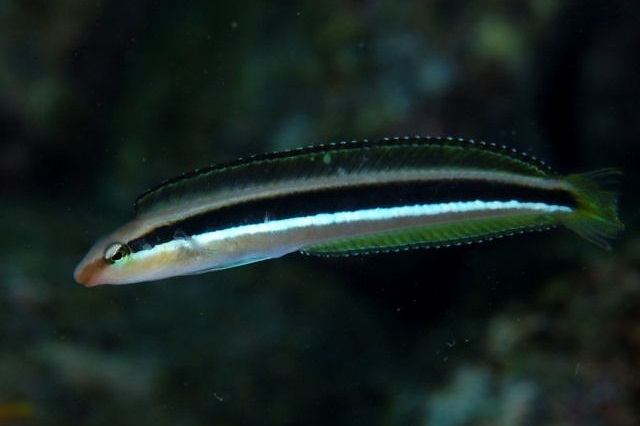Aspidontus dussumieri

| Latin name | Aspidontus dussumieri - (Valenciennes, 1836) |
|---|---|
| Local name | Lance blenny |
| Family | Blenniidae - Aspidontus |
| Origin | East Indian Ocean, West Indian Ocean, Australia, The Red Sea, Indonesia, East Pacific, Central/West Pacific |
| Max length | 12 cm (4.7") |
| Minimum volume |
150 l (40 gal) |
|---|---|
| Hardiness |
Hardy |
| Suitable for aquarium |
Suitable for special aquariums |
| Reef safe |
Always reef safe |
| Aggressiveness | Aggressive towards other species |
| Recommended |
Fish Zooplankton (Cyclops, pods...) |
|---|
This species is known to rip scales and flesh from other fish, therefore do not keep this species with other fish.
It might even bite humans.
These fish flourish better without other members of the same species in the aquarium.
This species needs good hiding places, for example, between live rocks.
Some species in this genus imitates cleaner wrasses.
There are many differences within the Toothcomb Blennies family, some eat algae whilst others eat zooplankton. There are many families of Blennies, this is merely one of them.
What they have in common are their oblong shape and long dorsal fin. Some species have small "legs" used to move around the bottom.
These Blennies do not normally get very big and are therefore a good choice for both small and large aquaria. They are not often very colorful, but many have a fun personality which many aquarists fall for.
The species of the families Aspidontus and Plagiotremus imitate Cleaner Wrasses and can therefore be difficult to identify.
| Aquarium trade | Yes |
|---|---|
| Distribution | Indo-Pacific: Red Sea south to Knysna, South Africa (Ref. 4404) and east to Tuamoto Islands, north to southern Japan, south to northern New South Wales; Palau to eastern Caroline Islands, Marshall Islands in Micronesia. |
| English common names |
Slender sabretooth blenny Lance blenny Dussumier's blenny |
Bob Fenner. Saber-Toothed Blennies, Family Blenniidae, Tribe Nemophini - Wet Web Media - (English)
Jeff Kurtz. 2007. Combtooth Blennies: Bewitching Bottom Dwellers - Tropical Fish Hobbyist - (English)
Scott W. Michael. Reef Aquarium Fishes: 500+ Essential-to-know Species - TFH Publications / Microcosm Ltd. - (English)
Bob Fenner. The True/Combtooth Blennies, Family Blenniidae - Wet Web Media - (English)
Bob Fenner. Blennioids: Blennies and Blenny-Like Fishes - Wet Web Media - (English)

